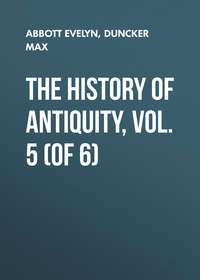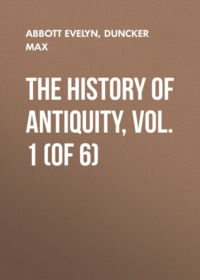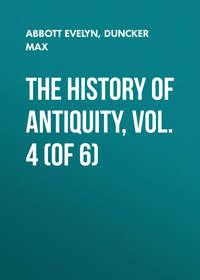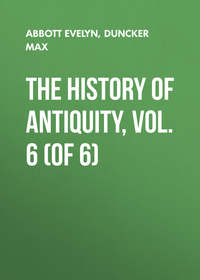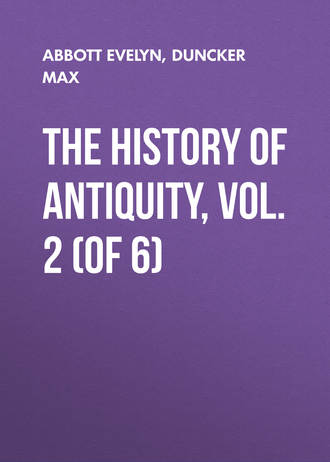 полная версия
полная версияThe History of Antiquity, Vol. 2 (of 6)
We found that the beginning of civilisation in Canaan could not be placed later than about the year 2500 B.C., and we must therefore allow a considerable antiquity to the cities of the Sidonians, Giblites, Arvadites, Zemarites and Arkites. The settlement on the site of Sidon was founded, no doubt, before the year 2000 B.C., and that on the site of Byblus cannot certainly be placed later than this period.66 The campaigns which the Pharaohs undertook against Syria and the land of the Euphrates after the expulsion of the Shepherds could not leave these cities unmoved. If the Zemar of the inscriptions of Tuthmosis III. is Zemar (Simyra) near Aradus, and Arathutu is Aradus itself, the territories of these cities were laid waste by this king in his sixth campaign (about the year 1580 B.C.); if Arkatu is Arka, south of Aradus, this place must have been destroyed in his fifteenth campaign (about the year 1570 B.C.). Sethos I. (1440-1400 B.C.) subdued the land of Limanon (i. e. the region of Lebanon), and caused cedars to be felled there. One of his inscriptions mentions Zor, i. e. Tyre, among the cities conquered by him. The son and successor of Sethos I., Ramses II., also forced his way in the first decades of the fourteenth century as far as the coasts of the Phenicians. At the mouth of the Nahr el Kelb, between Sidon and Berytus, the rocks on the coast display the memorial which he caused to be set up in the second and third year of his reign in honour of the successes obtained in this region.67 In the fifth year of his reign Ramses, with the king of the Cheta' defeats the king of Arathu in the neighbourhood of Kadeshu on the Orontes, and Ramses III. about the year 1310 B.C., mentions beside the Cheta who attack Egypt the people of Arathu, by which name, in the one case as in the other, may be meant the warriors of Aradus.68 If Arathu, like Arathutu, is Aradus, it follows, from the position which Ramses II. and III. give to the princes of Arathu, that beside the power to which the kingdom of the Hittites had risen about the middle of the fifteenth century B.C., and which it maintained to the end of the fourteenth,69 the Phenician cities had assumed an independent position. The successes of the Pharaohs in Syria come to an end in the first decades of the fourteenth century. Egypt makes peace and enters into a contract of marriage with the royal house of the Cheta; the Syrians obtain even the preponderance against Egypt (I. 152), to which Ramses III. towards the end of the fourteenth century was first able to oppose a successful defence.
The overthrow of the kingdom of the Hittites, which succumbed to the attack of the Amorites (I. 348) soon after the year 1300 B.C., must have had a reaction on the cities of the Phenicians. Expelled Hittites must have been driven to the coast-land, or have fled thither, and in the middle of the thirteenth century the successes gained by the Hebrews who broke in from the East, over the Amorites, the settlement of the Hebrews on the mountains of the Amorites, must again have thrown the vanquished, i. e. the fugitives of this nation, towards the coast.
With this retirement of the older strata of the population of Canaan to the coast is connected the movement which from this period emanates from the coasts of the Phenicians, and is directed towards the islands of the Mediterranean and the Ægean. It is true that on this subject only the most scanty statements and traces, only the most legendary traditions have come down to us, so that we can ascertain these advances only in the most wavering outlines. One hundred miles to the west off the coast of Phœnicia lies the island of Cyprus. On the southern coast of this island, which looked towards Phœnicia, stood the city of Citium, Kith and Chith in the inscriptions of the Phenicians, and apparently Kittii in those of the Assyrians. Sidonian coins describe Citium as a daughter of Sidon.70 After this city the whole island is known among the Semites as Kittim and Chittim; this name is even used in a wider sense for all the islands of the Mediterranean.71 The western writers state that before the time of the Trojan war Belus had conquered and subjugated the island of Cyprus, and that Citium belonged to Belus.72 The victorious Belus is the Baal of the Phenicians. The date of the Trojan war is of no importance for the settlement of the Phenicians in Cyprus, for this statement is found in Virgil only. More important is the fact that the settlers brought the Babylonian cuneiform writing to Cyprus. This became so firmly rooted in use that even the Greeks, who set foot on the island at a far later time, scarcely before the end of the ninth century, adopted this writing, which here meanwhile had gone through a peculiar development, and had become a kind of syllabic-writing, and used it on coins and in inscriptions even in the fifth century B.C.73 The settlement of the Sidonians in Cyprus must therefore have taken place before the time in which the alphabetic writing, i. e. the writing specially known as Phenician, was in use in Syria, and hence at the latest before 1100 B.C. How long before this time the settlement of the Phenicians in Cyprus took place can, perhaps, be measured by the fact that the Cyprian alphabet is a simplification of the old Babylonian cuneiform writing. The simplified form would undoubtedly have been driven out by the far more convenient alphabetic writing of the Phenicians if the Cyprian writing had not become fixed in use in this island before the rise of the alphabetic writing. Further, since the Phenicians, as we shall see, set foot on the coast of Hellas from about the year 1200 B.C. onwards, we must place the foundation of the colonies on the coasts nearest them, the settlement in Cyprus, before this date, about the middle of the thirteenth century B.C.
What population the Phenicians found on Cyprus it is not possible to discover. Herodotus tells us that the first inhabitants of the island were Ethiopians, according to the statements of the Cyprians. It is beyond a doubt that not Citium only, but the greater part of the cities of the island were founded by the Phenicians, and that the Phenician element became the ruling element of the whole island.74 It is Belus who is said to have conquered Cyprus, and to whom the city of Citium is said to belong; i. e. Citium worshipped the god Baal. At Amathus, to the west of Citium, on the south coast of the island, which was called the oldest city on Cyprus, and which nevertheless bears a distinctly Semitic name (Hamath), Adonis and Ashera-Astarte were worshipped,75 and these deities had also one of their oldest and most honoured seats of worship at Paphos (Pappa in the inscriptions), on the west coast. The Homeric poems represent Aphrodite as hastening to her altar at Paphos in Cyprus. Pausanias observes that the Aphrodite of Cyprus was a warlike Aphrodite,76 and as the daughters of the Cyprians surrendered themselves to the foreign seamen in honour of this goddess,77 it was the Astarte-Ashera of the Phenicians who was worshipped at Amathus and Paphos. The Zeus of the Cyprian city Salamis (Sillumi in the inscriptions of the Assyrians), to whom, according to the evidence of western writers, human sacrifices were offered, can only be Baal Moloch, the evil sun-god of the Phenicians. In the beginning of the tenth century B.C. the cities of Cyprus stood under the supremacy of the king of Tyre.78 The island was of extraordinary fertility. The forests furnished wood for ship-building; the mountains concealed rich veins of the metal which has obtained the name of copper from this island.79 Hence it was a very valuable acquisition, an essential strengthening of the power of Sidon in the older, and Tyre in the later, period.
Following Zeno of Rhodes, who wrote the history of his home in the first half of the second century B.C.,80 Diodorus tells us: The king of the Phenicians, Agenor, bade his son Cadmus seek his sister Europa,81 who had disappeared, and bring back the maiden, or not return himself to Phœnicia. Overtaken by a violent storm, Cadmus vowed a shrine to Poseidon. He was saved, and landed on the island of Rhodes, where the inhabitants worshipped before all other gods the sun, who had here begotten seven sons and among them Makar. Cadmus set up a temple in Rhodes to Poseidon, as he had vowed to do, and left behind Phenicians to keep up the service; but in the temple which belonged to Athena at Cnidus in Rhodes he dedicated a work of art, an iron bowl, which bore an inscription in Phenician letters, the oldest inscription which came from Phœnicia to the Hellenes. From Rhodes Cadmus came to Samothrace, and there married Harmonia. The gods celebrated this first marriage by bringing gifts, and blessing the married pair to the tones of heavenly music.82
Ephorus says that Cadmus carried off Harmonia while sailing past Samothrace, and hence in that island search was still made for Harmonia at the festivals.83 Herodotus informs us that Cadmus of Tyre, the son of Agenor, in his search for Europa, landed on the island of Thera, which was then called Callisto, and there left behind some Phenicians, either because the land pleased him or for some other reason. These Phenicians inhabited the island for eight generations before Theras landed there from Lacedæmon. The rest went to the island of Thasos and there built a temple to Heracles, which he had himself seen, and the city of Thasos. This took place five generations before Heracles the son of Amphitryon was born. After that Cadmus came to the land now called Bœotia, and the Phenicians who were with him inhabited the land and taught the Hellenes many things, among others the use of writing, "which as it seems to me the Hellenes did not possess before. They learnt this writing, as it was used by the Phenicians; in the course of time the form of the letters changed with the language. From these Phenicians the Ionians, among whom they dwelt, learnt the letters, altered their form a little, and extended their use. As was right, they called them Phenician letters, since the Phenicians had brought them into Greece. I have myself seen inscriptions in Cadmeian letters (i. e. from the time of Cadmus) in the temple of Ismenian Apollo at Thebes."84 According to the narrative of Hellanicus, Cadmus received an oracle, bidding him follow the cow which bore on her back the sign of the full moon, and found a city where she lay down. Cadmus carried out the command, and when the cow lay down wearied, where Thebes now stands, Cadmus built there the Cadmeia (the citadel of Thebes).85 According to the statement of Pherecydes Cadmus also built the city of Thebes.86 With Hecatæus of Miletus Cadmus passes as the discoverer of letters; according to others he also discovered the making of iron armour and the art of mining.87
The direction of the Phenician settlements, which proceeds in the Ægean sea from S.E. to N.W., cannot be mistaken in these legends. First Rhodes, then the Cyclades, then the islands on the Thracian coast, Samothrace and Thasos, were colonised; and at length, on the strait of Eubœa, the mainland of Hellas was trodden by the Phenicians, who are said to have gained precisely from this point a deep-reaching influence over the Hellenes. The legend of Cadmus goes far back among the Greeks. In the Homeric poems the inhabitants of Thebes are "Cadmeians." The Thebaid praised "the divine wisdom of Cadmus;" in the poems of Hesiod he leads home Harmonia, "the daughter of Ares and Aphrodite," and Pindar describes how the Muses sang for "the divine Cadmus, the wealthiest of mortals, when in seven-gated Thebes he led the ox-eyed Harmonia to the bridal-bed."88 Agenor, the father of Cadmus, is a name which the Greeks have given to the Baal of the Phenicians.89 Cadmus himself, the wealthiest of mortals, who leads home the daughter of a god and a goddess, – who celebrates the first marriage at which the gods assemble, bring gifts and sing, – whose wife was worshipped as the protecting goddess of Thebes,90– whose daughters, Ino, Leucothea and Semele, are divine creatures, whom Zeus leads to the Elysian fields,91– can only be a god. He seeks the lost Europa, and is to follow the cow which bears the sign of the full moon. We know the moon-goddess of the Phenicians, who bears the crescent moon and cow's horns, the horned Astarte, who wears a cow's head, the goddess of battle and sensual desire, and thus the daughter of Ares and Aphrodite. "The great temple of Astarte at Sidon," so we find in the book of the Syrian goddess, "belongs, as the Sidonians say, to Astarte; but a priest told me that it was a temple of Europa, the sister of Cadmus." The meaning of the word Europa has been discussed previously (I. 371). Cadmus, who seeks the lost moon-goddess, who at length finds and overcomes her, and celebrates with her the holy marriage, is the Baal Melkarth of the Phenicians. The death-bringing Istar-Astarte is changed into Bilit-Ashera, into the fruit-giving goddess;92 the gloomy Europa changes into Harmonia, the goddess of union, birth and increase, yet not without leaving to her descendants deadly gifts. It is the myth of Melkarth and Astarte which the Greeks present to us in the story of Cadmus; with this myth they have connected the foundation of the Phenician settlements in Rhodes, Thera, Samothrace, Thasos and Bœotia; they have changed it into the foundation of these colonies. The name Cadmus means the man of the East; to the Hebrews the Arabs who dwelt to the east of them were known as Beni Kedem, i. e. sons of the East.93 To the Greeks the Phenicians were men of the East, just as to the English of the thirteenth century the merchants of Lubeck were Easterlings. The citadel of Thebes, which the men of the East built, preserved the name of Cadmus the son of the East, and kept it alive among the Greeks.
What we can gather from Grecian legend is confirmed by some statements of historians and by traces which tell of settlements of the Phenicians. Thucydides informs us that the Phenicians colonised most of the islands of the Ægean.94 Diodorus has already told us with regard to Rhodes that in the temples of this island were Phenician works of art and inscriptions, and that in Rhodes the sun-god and the seven children which he begot there were worshipped. In the number eight made by these deities we can hardly fail to recognise the eight great deities of the Phenicians; the sun-god at their head is the Baal of the Phenicians (I. 357). And if Diodorus mentions Makar among the seven sons of the sun-god of Rhodes, – if according to others Rhodes, like Cyprus, was called Macaria, – Makar is a Greek form of the name Melkarth. We further learn that on the highest mountain summit in Rhodes, on Atabyris, Zeus was worshipped under the form of a bull, and that a human sacrifice was offered yearly to Cronos. In Atabyris we cannot fail to recognise the Semitic Tabor, i. e. the height. We found above that the Phenicians worshipped Baal under the form of a bull, and the Greeks are wont to denote Baal Moloch by the name of Cronos.95 These forms of worship continued to exist even when at a later time Hellenic immigrants had got the upper hand in Rhodes. It was the Dorians who here met with resistance from the Phenicians at Camirus and Ialysus; they got the upper hand, but admitted Phenician families into their midst,96 and continued their sacred rites. Diodorus informs us that the Phenicians whom Cadmus had left behind on Rhodes had formed a mixed community with the Ialysians, and that it was said that priests of their families had performed the sacred duties.97 Even at a later time Rhodes stood in close relation with Phœnicia, especially with the city of Aradus.98 Thus it happened that the colonies which the Rhodians planted in the seventh and sixth centuries in Sicily, Gela and Acragas, carried thither the worship of Zeus Atarbyrius. Zeus Atarbyrius was the protecting deity of Acragas, and human sacrifices were offered to his iron bull-image on the citadel of that city as late as the middle of the sixth century. The coins of Gela also exhibit a bull.99 Of the island of Thera, Herodotus told us that the Phenicians colonised it and inhabited it for eight generations, i. e. for more than 250 years according to his computation. Herodotus names the chief of the Phenicians whom Cadmus left behind on Thera; others speak of the two altars which he erected there.100 The descendants of these Phenicians were found here by the Greek settlers from Laconia. It is certain that even in the third century B.C. the island worshipped the hero Phœnix.101 Of the island of Melos we learn that it was occupied by Phenicians of Byblus, and named by them after their mother city;102 the island of Oliaros near Paros was, on the other hand, according to Heraclëides Ponticus, occupied by the Sidonians.103 Strabo informs us that Samothrace was previously called Melite (Malta); from its height (the island is a mountain rising high in the sea and covered with oak forests; the summit reaches 5000 feet) it obtained the name of Samos, "for high places are called Sami;"104 as a matter of fact the stem of the word of this meaning, like the name Melite, belongs to the Phenician language. Ephorus has already told us (p. 56) that the Samothracians sought for Harmonia at their festivals; Diodorus represents Cadmus as celebrating the marriage with Harmonia on Samothrace as well as at Thebes, and we learn from Herodotus that the Cabiri, i. e. the great gods of the Phenicians, were worshipped on Samothrace; votive tablets of the island dating from Roman times still bear the inscription, "to the great gods," i. e. to the Cabiri.105 The islands of Imbros and Lemnos also worshipped the Cabiri; Lemnos especially worshipped Hephæstus, who had a leading place in this circle.106 The island of Thasos is said, according to the statement of the Greeks, to have been called after a son of Phœnix, or Agenor, of the name of Thasos, who was consequently a brother of Cadmus. Herodotus saw on the island a temple which the Phenicians had built to Heracles, i. e. to Baal-Melkarth, and the mines which they had made on the coast opposite Samothrace; "they had overturned a great mountain in order to get gold from it."107 Herodotus also tells us that the temple of Aphrodite Urania on the island of Cythera off the coast of Laconia was founded by the Phenicians, and Pausanias calls this temple the oldest and most sacred temple of Urania among the Hellenes; the wooden image in this temple exhibited the goddess in armour. Aphrodite Urania is with the Greeks the Syrian Aphrodite; if she was represented on Cythera in armour it is clear that she was worshipped there by the Phenicians as Astarte-Ashera, i. e. as the goddess of war and love.108
Not in the islands only, but on the coasts of Hellas also, the Phenicians have left traces of their ancient occupation, especially in the form of worship belonging to them. On the isthmus of Corinth Melicertes, i. e. Melkarth, was worshipped as a deity protecting navigation; Corinthian coins exhibit him on a dolphin.109 Aphrodite, whose shrine stood on the summit of Acrocorinthus, was worshipped by prostitution like the Ashera-Bilit of the Phenicians. In Attica also, in the deme of Athmonon, there was a shrine of the goddess of Cythera, which king Porphyrion, i. e. the purple man, the Phenician, is said to have founded there at a very ancient time "before king Actaeus."110 At Marathon, where Heracles was worshipped, and of whom the name represents the Phenician city Marathus, rose a fountain which had the name Makaria, i. e. Makar,111 the name of Melkarth, which we have already met with in Cyprus and Rhodes, and shall meet with again. More plainly still do the tombs lately discovered in Hymettus at the village of Spata attest the ancient settlement of the Phenicians on the Attic coast. These are chambers dug deeply into the rock after the Phenician manner, with horizontal roofs after the oldest fashion of Phenician graves; and shafts lead down to them from the surface. The ornaments and works in glass, ivory, gold and brass discovered here, which are made after Babylonian and Egyptian models, can only have been brought by the Phenicians.112 The citadel of Thebes, as has been said, retains the name of Cadmus; the poetry of the Greeks praised the mighty walls, the seven gates of Thebes. We know the number seven of the great Phenician gods; we can prove that the seven gates were dedicated to the gods of the sun, the moon and the five planets;113 and the Greeks have already admitted to us that they received the wearing of armour, the art of mining and masonry and finally their alphabet from Cadmus, i. e. from the Phenicians, the Cadmeans of Thebes.
In the Homeric poems Europa, the daughter of Phœnix, bears Minos to Zeus. The abode of Minos is the "great city" of Cnossus in Crete; he receives each nine years the revelations of his father Zeus; for his daughter Ariadne Dædalus adorns a dancing place at Cnossus. After his death Minos carries in the under world the golden sceptre, and by his decisions puts an end to the contentions of the shades.114 His descendants rule in Crete.115 Later accounts tell us that Zeus in the form of a bull carried off Europa from Phœnicia, and bore her over the sea to Crete. The wife of her son Minos, Pasiphaë, then united with a bull which rose out of the sea, and brought forth the Minotaur, i. e. the Minos-bull, a man with a bull's head.116 The son of Minos, Androgeos (earth-man) or Eurygyes (Broadland), was destroyed in Attica by the bull of Marathon, who consumed him in his flames.117 To avenge the death of Androgeos Minos seized Megara, and blight and famine compelled the Athenians to send, in obedience to the command of Minos, seven boys and seven girls every ninth year to Crete, who were then sacrificed to the Minotaur.118 Others narrate that Hephæstus had given Minos a man of brass, who wandered round the island and kept off foreign vessels, and clasped to his glowing breast all who were disobedient to Minos.119 When Dædalus retired before the wrath of Minos from Crete to Sicily, Minos equipped his ships to bring him back; but he there found, according to Herodotus, a violent death.120 The king of the Sicanians, so Diodorus tells us, gave him a friendly welcome, and caused a warm bath to be prepared, and then craftily suffocated him in it. The Cretans buried their king in a double grave; they laid the bones in a secret place, and built upon them a temple to Aphrodite, and as they could not return to Crete because the Cretans had burned their ships, they founded the city Minoa in Sicily; but the tomb of Minos was shown in Crete also.121
A bull-god carries the daughter of Phœnix over the sea to Crete and begets Minos; a bull who rises out of the sea begets with Pasiphaë, i. e. the all-shining, the Minos-bull, to which in case of blight and famine boys and girls are sacrificed in the number sacred among the Semites; Androgeos succumbs to the heat of the bull of Marathon, an iron man slays his victims by pressing them to his glowing breast. These legends of the Greeks are unmistakable evidence of the origin of the rites observed in Crete from the coast of Syria, of the settlement of Phenicians in Crete. The bull-god may be the Baal Samim or the Baal Moloch of the Phenicians; Europa has already revealed herself to us as the moon-goddess of the Phenicians (p. 58); Pasiphaë is only another name for the same goddess, the lady of the nightly sky, the starry heaven. We know that on occasions of blight human sacrifices were offered to Baal Moloch, the fiery, consuming, angry sun-god, and that these sacrifices were burnt. Ister, a writer of the third century B.C., tells us quite simply; In ancient times children were sacrificed to Cronos in Crete.122 Before the harbour of Megara lay an island of the name of Minoa; at the time of the summer heat before the corn was ripe, the Athenians offered peace-offerings at the Thargelia, "in the place of human sacrifices,"123 that the consuming sun might not kill the harvest. The name of the island and this custom, as well as the flames of the bull of Marathon, prove that beside the worship of the Syrian goddess at Athmonon, and the worship of Melkarth at Marathon, the worship of Baal Moloch had penetrated as far as Megara and Attica. Minos, the son of the sky-god, the husband of the moon-goddess, who from time to time receives revelations from heaven, and even after his death is judge of the dead, is himself a god; his proper name is Minotaur, a name taken from the form of the bull's image and the bull's head. When Baal Melkarth had found and overcome Astarte, after he had celebrated with her the holy marriage, he went to rest according to the Phenician myth in the waters of the western sea which he had warmed. The Phenicians were of opinion that the beams of the sun when sinking there in the far west had the most vigorous operation because of their greater proximity.124 Minos goes to Sicily; there in a hot bath he ends his life, and over his resting-place rises the temple of Astarte-Ashera, with whom he celebrated his marriage in the west, and who by this marriage is changed from the goddess of war into the goddess of love. The tombs of Minos in Crete, Sicily, and finally at Gades, of which the Greeks speak, are in the meaning of the Phenician myth merely resting-places of the god, who in the spring wakes from his slumber into new power. The Greeks made Minos, who continued to live in the under-world, a judge in the causes of the shades, and finally a judge of the souls themselves. On the southern coast of Sicily, at the mouth of the Halycus, lay the city which the Greeks called Minoa or Heraclea-Minoa after Minos. To the Phenicians it was known as Rus Melkarth (p. 78), a title which proves beyond doubt that Minos was one of the names given by the Greeks to this god of the Phenicians.




